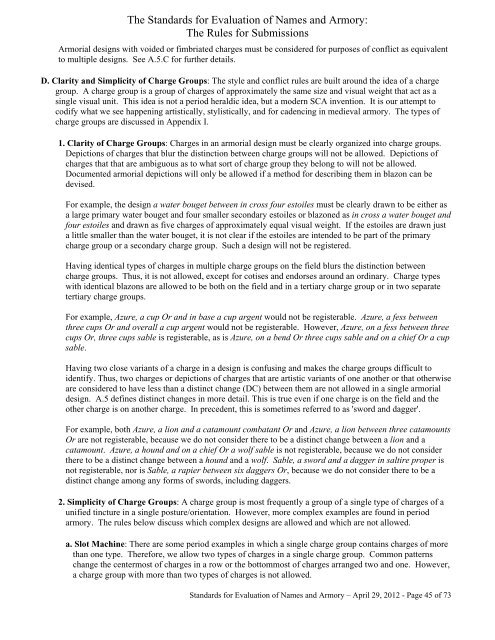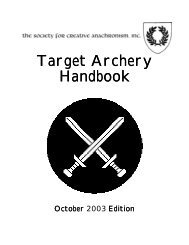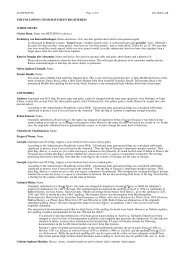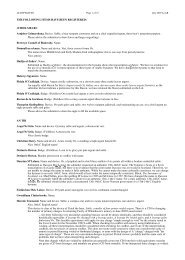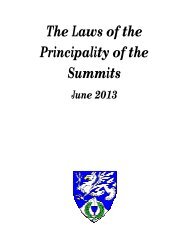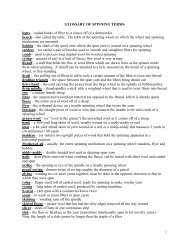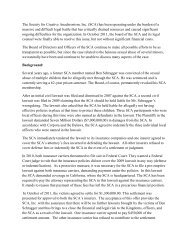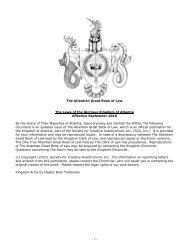The Standards for Evaluation of Names and Armory - SCA Heraldry
The Standards for Evaluation of Names and Armory - SCA Heraldry
The Standards for Evaluation of Names and Armory - SCA Heraldry
You also want an ePaper? Increase the reach of your titles
YUMPU automatically turns print PDFs into web optimized ePapers that Google loves.
<strong>The</strong> <strong>St<strong>and</strong>ards</strong> <strong>for</strong> <strong>Evaluation</strong> <strong>of</strong> <strong>Names</strong> <strong>and</strong> <strong>Armory</strong>:<strong>The</strong> Rules <strong>for</strong> SubmissionsArmorial designs with voided or fimbriated charges must be considered <strong>for</strong> purposes <strong>of</strong> conflict as equivalentto multiple designs. See A.5.C <strong>for</strong> further details.D. Clarity <strong>and</strong> Simplicity <strong>of</strong> Charge Groups: <strong>The</strong> style <strong>and</strong> conflict rules are built around the idea <strong>of</strong> a chargegroup. A charge group is a group <strong>of</strong> charges <strong>of</strong> approximately the same size <strong>and</strong> visual weight that act as asingle visual unit. This idea is not a period heraldic idea, but a modern <strong>SCA</strong> invention. It is our attempt tocodify what we see happening artistically, stylistically, <strong>and</strong> <strong>for</strong> cadencing in medieval armory. <strong>The</strong> types <strong>of</strong>charge groups are discussed in Appendix I.1. Clarity <strong>of</strong> Charge Groups: Charges in an armorial design must be clearly organized into charge groups.Depictions <strong>of</strong> charges that blur the distinction between charge groups will not be allowed. Depictions <strong>of</strong>charges that that are ambiguous as to what sort <strong>of</strong> charge group they belong to will not be allowed.Documented armorial depictions will only be allowed if a method <strong>for</strong> describing them in blazon can bedevised.For example, the design a water bouget between in cross four estoiles must be clearly drawn to be either asa large primary water bouget <strong>and</strong> four smaller secondary estoiles or blazoned as in cross a water bouget <strong>and</strong>four estoiles <strong>and</strong> drawn as five charges <strong>of</strong> approximately equal visual weight. If the estoiles are drawn justa little smaller than the water bouget, it is not clear if the estoiles are intended to be part <strong>of</strong> the primarycharge group or a secondary charge group. Such a design will not be registered.Having identical types <strong>of</strong> charges in multiple charge groups on the field blurs the distinction betweencharge groups. Thus, it is not allowed, except <strong>for</strong> cotises <strong>and</strong> endorses around an ordinary. Charge typeswith identical blazons are allowed to be both on the field <strong>and</strong> in a tertiary charge group or in two separatetertiary charge groups.For example, Azure, a cup Or <strong>and</strong> in base a cup argent would not be registerable. Azure, a fess betweenthree cups Or <strong>and</strong> overall a cup argent would not be registerable. However, Azure, on a fess between threecups Or, three cups sable is registerable, as is Azure, on a bend Or three cups sable <strong>and</strong> on a chief Or a cupsable.Having two close variants <strong>of</strong> a charge in a design is confusing <strong>and</strong> makes the charge groups difficult toidentify. Thus, two charges or depictions <strong>of</strong> charges that are artistic variants <strong>of</strong> one another or that otherwiseare considered to have less than a distinct change (DC) between them are not allowed in a single armorialdesign. A.5 defines distinct changes in more detail. This is true even if one charge is on the field <strong>and</strong> theother charge is on another charge. In precedent, this is sometimes referred to as 'sword <strong>and</strong> dagger'.For example, both Azure, a lion <strong>and</strong> a catamount combatant Or <strong>and</strong> Azure, a lion between three catamountsOr are not registerable, because we do not consider there to be a distinct change between a lion <strong>and</strong> acatamount. Azure, a hound <strong>and</strong> on a chief Or a wolf sable is not registerable, because we do not considerthere to be a distinct change between a hound <strong>and</strong> a wolf. Sable, a sword <strong>and</strong> a dagger in saltire proper isnot registerable, nor is Sable, a rapier between six daggers Or, because we do not consider there to be adistinct change among any <strong>for</strong>ms <strong>of</strong> swords, including daggers.2. Simplicity <strong>of</strong> Charge Groups: A charge group is most frequently a group <strong>of</strong> a single type <strong>of</strong> charges <strong>of</strong> aunified tincture in a single posture/orientation. However, more complex examples are found in periodarmory. <strong>The</strong> rules below discuss which complex designs are allowed <strong>and</strong> which are not allowed.a. Slot Machine: <strong>The</strong>re are some period examples in which a single charge group contains charges <strong>of</strong> morethan one type. <strong>The</strong>re<strong>for</strong>e, we allow two types <strong>of</strong> charges in a single charge group. Common patternschange the centermost <strong>of</strong> charges in a row or the bottommost <strong>of</strong> charges arranged two <strong>and</strong> one. However,a charge group with more than two types <strong>of</strong> charges is not allowed.<strong>St<strong>and</strong>ards</strong> <strong>for</strong> <strong>Evaluation</strong> <strong>of</strong> <strong>Names</strong> <strong>and</strong> <strong>Armory</strong> – April 29, 2012 - Page 45 <strong>of</strong> 73


